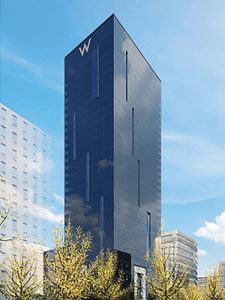INTERNATIONAL REPORT—Japan’s hotel market has been gaining traction. While local and regional brands have been the ones doing much of the developing, global brands are moving in on territories. Several cities in Japan are thriving, and brands—both global and regional—may want to expand their reach within the country.
“There has not been much new development in Japan for more than 20 years,” said Bruce Ford, SVP of director of global business development at Lodging Econometrics.
According to the latest data provided by Lodging Econometrics, Japan’s construction pipeline consists of 219 projects and 44,083 rooms (all in various stages of planning). The majority of the country’s projects are upper-midscale (83 projects with 15,911 rooms), followed by economy (54 projects with 6,342 rooms) and upscale (37 projects with 13,469 rooms).
“We have observed pipeline growth in Japan for two straight years, including a nearly 10% uptick in just the past 90 days,” he said. “A lot of the same chain scales we are seeing around the world are coming to the region, including upscale and upper-midscale. Similar to China, a large amount of modern economy lodging is also in the pipeline.”
There’s room for growth in Japan, according to CBRE’s most recent Japan Hotel Market Outlook. By the end of 2020, the total number of new hotel rooms will hit 80,000 rooms. The growth of Japan’s inbound tourism has driven the “industry’s buoyant performance,” according to CBRE.
There are several reasons why Japan has been seeing an increase in foreign visitors. “First, the number of overseas tourists in Asia, especially from China (and Korea, Taiwan), have been increasing due to Asian economic growth,” said Kiyoshi Tsuchiya, director of CBRE Hotels Asia-Pacific. “Second, the Japanese government mitigated visa requirements for Asian countries; in early 2015, it was relaxed with China and the increase in visitor numbers followed.” Lastly, the Japanese yen continues to depreciate.
The number of inbound tourists visiting Japan in 2017 rose by 19% year-over-year to 28.69 million, according to CBRE. Japan’s government set a target of hitting 40 million inbound tourists in 2020. CBRE believes Japan’s government will be able to achieve this mark on this target even if the future rate of growth slows to an annual average of 12%.
The Chinese are hitting Japan’s market hard. More than 7,355,800 people from China visited Japan in 2017 (a year-over-year increase of 15.4%). “Visitors from China have been growing strongly in the region generally,” he said. “The proportion visiting Japan is quite small. In 2018, we are not sure whether China will hold the number one spot or not.” That’s because visitors from another country close by are closing in on the leader.
With 7,140,200 foreign visitors, South Korea is directly behind China. “South Korea and Japan have had strong economic and cultural ties for many years, and Koreans appreciate and recognize this,” he said. Taking third (and southwest of Korea) is Taiwan.
“Taiwan, China and South Korea are the three countries physically closest to Japan and have a good understanding of Japan—hence they dominate the numbers,” Tsuchiya said.
The top two markets in Japan are Tokyo and Osaka City. There are more than 21,000 hotel rooms in the pipeline in Tokyo (many of the projects are located in East Tokyo and Ginza, a popular upscale shopping area), according to CBRE. In Osaka City, the development pipeline has reached more than 17,800 rooms, with the majority of projects concentrated in the following: Umeda, Yodoyabashi and Shinsaibashi/Namba.
“Hospitality demand is strong for both domestic and inbound visitors in [Tokyo and Osaka],” Tsuchiya said. “Both are very strong economically, so business demand is equally strong. For tourists, these two cities have excellent attractions and sightseeing opportunities and these are the gateway cities for other sightseeing spots. These inherent characteristics will ensure their continued dominance.”
CBRE is forecasting a shortage of rooms in Tokyo, however (a shortfall of around 3,500 rooms). The firm’s estimate doesn’t take into account the temporary increase in inbound tourists expected during the 2020 Tokyo Olympics, so the deficit could be even tighter.
CBRE expects estimated hotel rooms to exceed estimated demand by 13,500 rooms in Osaka City. The commercial real estate services and investment firm carefully pointed out the following, however: These additional rooms don’t necessarily indicate oversupply in the city. Why? New supply could actually encourage a recovery in market demand.
Select companies and brands with leading pipelines in Japan include the following names: Livemax Co.’s Hotel Livemax brand (with 39 projects and 3,020 rooms); Route Inn’s Route Inn (with 36 projects and 6,736 rooms); APA Hotel LTD’s APA Hotel (with 23 projects and 9,712 rooms); Marriott International’s Edition (with 13 projects and 2,380 rooms); and Toyoko Inn Co Ltd’s Tokyo Inn (with 11 projects and 2,636 rooms).
Marriott currently has 41 hotels open in Japan under 12 brands, with another 14 properties in the pipeline. “We expect to see hotel growth continue as inbound visitors continue to grow year on year at double-digit growth rates,” said Paul Foskey, chief development officer at Marriott. “However, we do expect some of the strong growth to temper as the new supply coming online around 2020 gets absorbed into the market.” Between 2017 and 2020, the hospitality global company will launch multiple new brands into Japan (including Moxy, AC, Aloft, JW, Edition and W). The hotel group will roll Bulgari out in the country in 2022. Marriott in November 2017 opened up Moxy properties in both Tokyo and Osaka: Moxy Tokyo Kinshicho and Moxy Osaka Honmachi.
While global brands have been moving into the region, there’s still more opportunity for them. “Although we have not seen expansive growth with global brands in Japan as of yet, we are expecting a breakthrough with that type of development likely coming soon,” Ford said. “Most of the new-development projects right now are local and regional brands looking to expand their existing portfolios.”
Although, brands looking to build properties in Japan may want to look outside of the top markets in the country—for now.
“Many hotels will be opened this year in three major areas: Tokyo, Osaka and Kyoto,” Tsuchiya said. “Although the number of inbound visitors grows, hotel performance will not grow significantly in those cities because of new supply. There should be more opportunities for growth in other cities/areas.” HB



